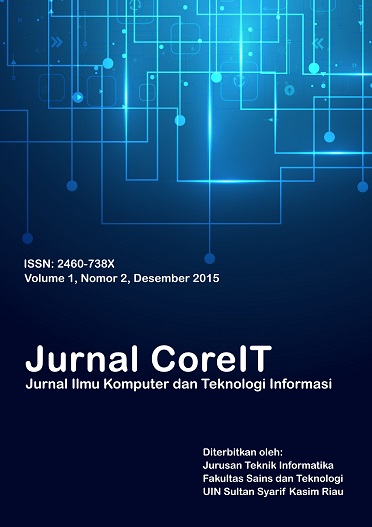Analisa dan Perbaikan Algoritma Line Maze Solving Untuk Jalur Loop, Lancip, dan Lengkung pada Robot Line Follower (LFR)
DOI:
https://doi.org/10.24014/coreit.v1i2.1231Abstract
Pengujian robot line follower pada penelitian ini menggunakan arduino uno. Pada penelitian sebelumnya algoritma line maze solving yang digunakan sebagai metode pada robot line follower masih menyisakan kendala, di mana robot belum bisa melewati maze dengan jalur loop, jalur lengkung lebih dari 225 derajat, dan jalur lancip kurang dari sudut 45 derajat. Oleh karena itu dilakukan perbaikan, dan didapatkan algoritma yang baru. Algoritma ini kemudian diuji kembali pada robot dan berhasil menyelesaikan maze dengan jalur loop, jalur lengkung lebih dari 225 derajat , dan jalur lancip kurang dari 45 derajat.
References
Sholahuddin, Asep, dan Setiawan Hadi. “Penerapan Jaringan Syaraf Tiruan Pada Pengenalan Pola Robot Line Follower”. Prosiding Seminar Nasional Sains dan Teknologi Nuklir. PTNBR – BATAN Bandung, 4 Juli 2013.
Vanoy, Richard T., II. Design a Line Maze Solving Robot: Teaching a Robot to Solve a Line Maze. April 2009.
Musridho, R. Joko. Yanto, Febi. 2014. Analisa Performa Algoritma Line Maze Solving Pada Jalur Lengkung Dan Zigzag. Prosiding SNTIK5 UIN SUSKA RIAU.
Rudiyanto, Hariz Bafdal. "Rancang Bangun Robot Pengantar Surat Menggunakan Mikrokontroler AT89S51". Jurnal Skripsi. Jurusan Teknik Elektro, Universitas Gunadarma, 2010.
Margolis, Michael. Make an ArduinoControlled Robot. Sebastopol:
O’Reilly Media, Inc., 2013.
Djuandi, Feri. Pengenalan Arduino. Juli 2011. [Online] Tersedia:
http://www.tobuku.com/docs/ArduinoPengenalan.pdf, diakses 4 juli 2014.
Hendriawan, Akhmad, dan Reesa Akbar. Penyelesaian Jalur Terpendek dengan menggunakan Algoritma Maze Mapping Pada Line Maze. Jurusan Teknik Elektronika, Politeknik Elektronika Negeri Surabaya, Institut Teknologi Sepuluh November, 2010.
Downloads
Issue
Section
License
The Authors submitting a manuscript do so on the understanding that if accepted for publication, copyright of the article shall be assigned to CoreIT journal and published by Informatics Engineering Department Universitas Islam Negeri Sultan Syarif Kasim Riau as publisher of the journal.
Authors who publish with this journal agree to the following terms:
Authors automatically transfer the copyright to the journal and grant the journal right of first publication with the work simultaneously licensed under a Creative Commons Attribution-ShareAlike (CC BY SA) that allows others to share the work with an acknowledgement of the work's authorship and initial publication in this journal.
Authors are able to enter into separate permission for non-exclusive distribution of the journal's published version of the work (e.g., post it to an institutional repository or publish it in a book), with an acknowledgement of its initial publication in this journal.
Authors are permitted and encouraged to post their work online (e.g., in institutional repositories or on their website) prior to and during the submission process, as it can lead to productive exchanges, as well as earlier and greater citation of published work (See The Effect of Open Access).

